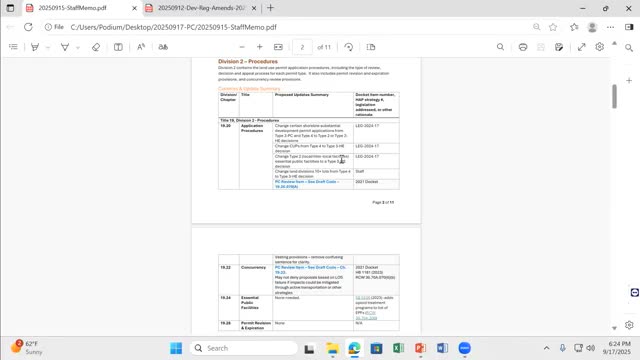Committee Discusses Household Zoning Definitions and Essential Public Facilities
September 18, 2025 | Anacortes, Skagit County, Washington
This article was created by AI summarizing key points discussed. AI makes mistakes, so for full details and context, please refer to the video of the full meeting. Please report any errors so we can fix them. Report an error »

The City of Anacortes Planning Commission convened on September 17, 2025, to discuss several key topics related to zoning definitions and essential public facilities. The meeting began with a review of the staff memo, which highlighted the complexities surrounding the term "family" in zoning regulations.
Commission members noted that the current definition of "family" includes individuals living together, regardless of their relationship. This has led to a suggestion to shift from "single-family zoning" to "single-household zoning," as the term "family" may no longer accurately reflect the diverse living arrangements in the community. The discussion emphasized that state law prohibits cities from regulating the number of unrelated individuals living together, raising questions about the necessity of the term "family" in the zoning code.
The conversation then transitioned to essential public facilities (EPFs), with a focus on the distinction between Type 1 and Type 2 EPFs. Type 1 facilities are major public services that serve multiple counties, such as regional transportation hubs and state correctional facilities. In contrast, Type 2 facilities are local in nature, such as schools. The commission discussed the implications of these classifications, particularly in relation to a behavioral health center in Cedra Woolly, which was categorized as a Type 1 facility due to its broader service area.
Overall, the meeting highlighted the ongoing challenges in updating zoning definitions to reflect modern living arrangements and the importance of understanding the classification of public facilities in city planning. The commission plans to continue exploring these topics in future meetings to ensure that regulations align with community needs and state laws.
Commission members noted that the current definition of "family" includes individuals living together, regardless of their relationship. This has led to a suggestion to shift from "single-family zoning" to "single-household zoning," as the term "family" may no longer accurately reflect the diverse living arrangements in the community. The discussion emphasized that state law prohibits cities from regulating the number of unrelated individuals living together, raising questions about the necessity of the term "family" in the zoning code.
The conversation then transitioned to essential public facilities (EPFs), with a focus on the distinction between Type 1 and Type 2 EPFs. Type 1 facilities are major public services that serve multiple counties, such as regional transportation hubs and state correctional facilities. In contrast, Type 2 facilities are local in nature, such as schools. The commission discussed the implications of these classifications, particularly in relation to a behavioral health center in Cedra Woolly, which was categorized as a Type 1 facility due to its broader service area.
Overall, the meeting highlighted the ongoing challenges in updating zoning definitions to reflect modern living arrangements and the importance of understanding the classification of public facilities in city planning. The commission plans to continue exploring these topics in future meetings to ensure that regulations align with community needs and state laws.
View full meeting
This article is based on a recent meeting—watch the full video and explore the complete transcript for deeper insights into the discussion.
View full meeting
